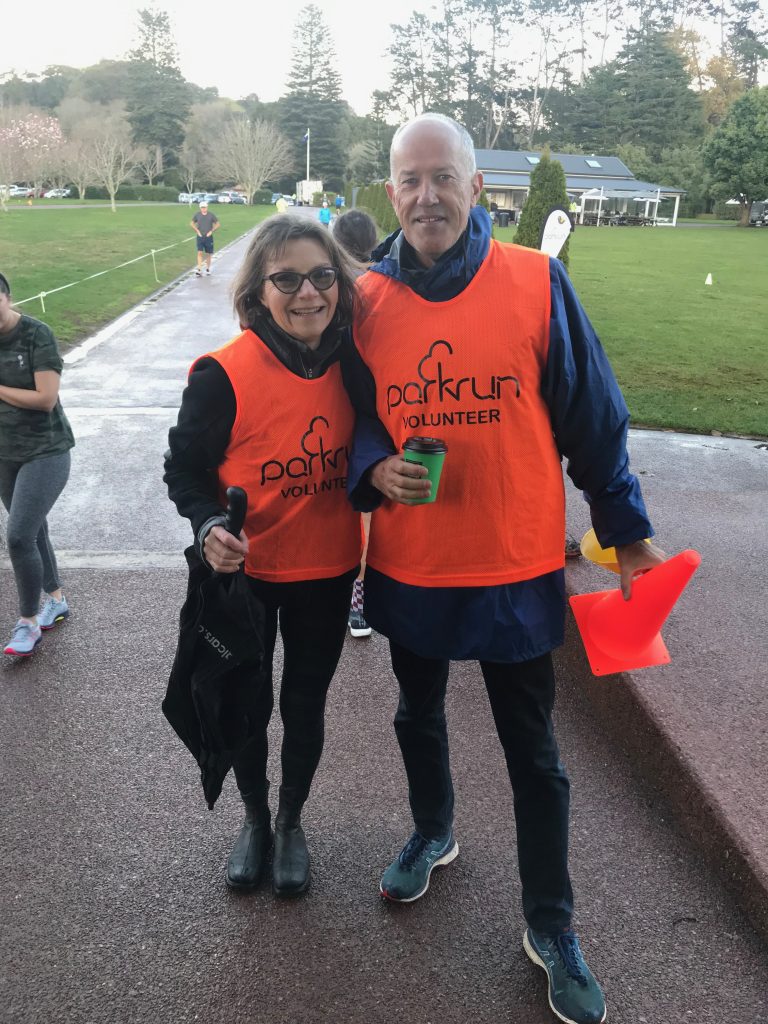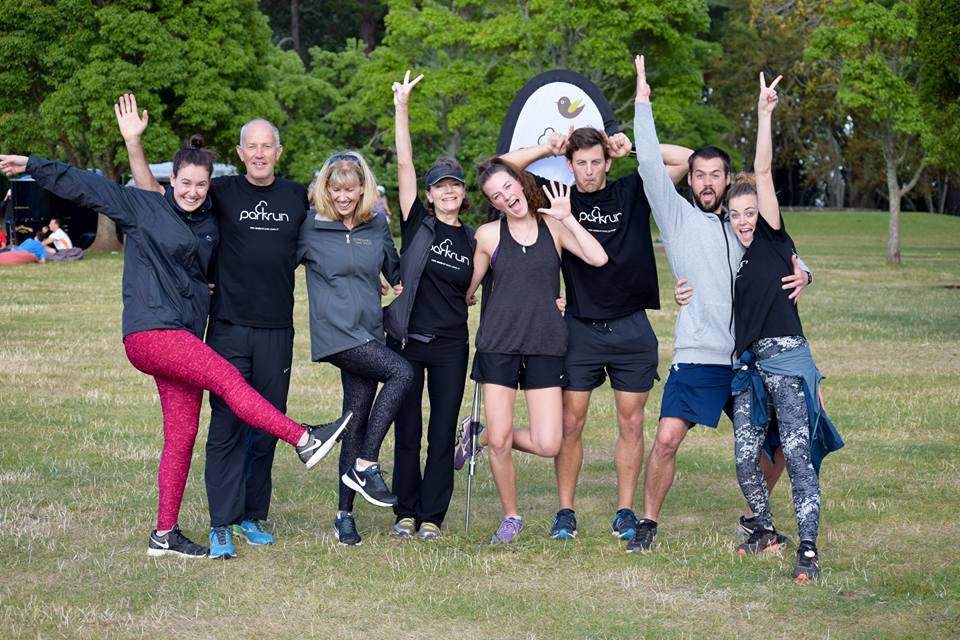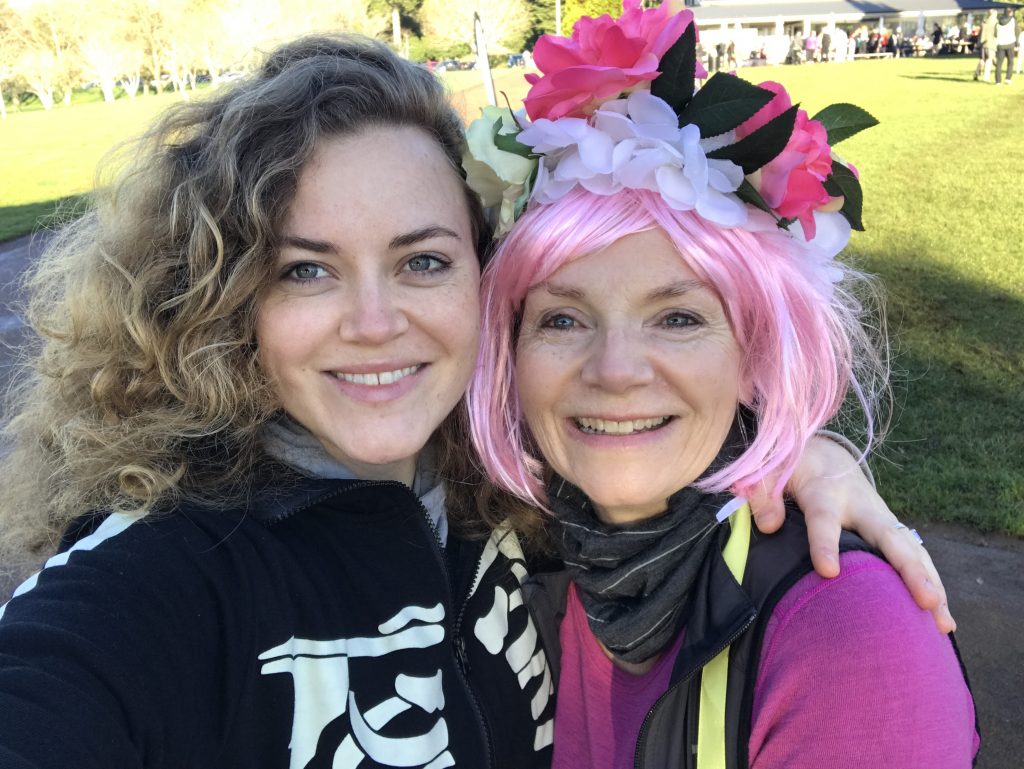parkrun came to New Zealand by way of three people – country managers Noel and Lian de Charnoy and parkrunner Richard McChesney.
To celebrate parkrun New Zealand’s 8th birthday parkrun wrote this blog post.
I’ve spoken to Noel and Lian de Charmoy, founding country managers, as well as Richard McChesney, the founding event director of Lower Hutt parkrun.
Noel and Lian de Charmoy
It was May 5th 2012 when parkrun officially took root in New Zealand, but the seeds were planted years earlier.

In fact, you could probably trace it right back to the 1980s, when parkrun founder Paul Sinton-Hewitt was working for Standard Bank in South Africa.
A few of the employees would run together at lunchtime.
“There were a couple of us who would do a lot of mileage,” says Noel de Charmoy.
“There was myself, Brian Chamberlain (a South African marathon champion), a few others and Paul joined us. We all lived close together so we’d often run together. We just became family friends.
“There were lots of club runs on the weekends and during the week, usually around 8km, There was one around the corner from us that was 5km. We did it most Saturdays.
“It was a time trial and that’s why Bushy Park was called a time trial when it originally started. It was really just for keen runners, no walkers at the back of the field like you find at parkrun now.”
The de Charmoys go to Bushy
Paul moved to the UK in 1989 but the de Charmoy’s stayed in touch and visited him in London. They moved to New Zealand in 2002.
And then the Bushy Park Time Trial started in October 2004 with 13 runners.
“Paul came to visit us here in New Zealand in 2005 and told us about what is now parkrun,” says Lian
In 2009 they went to the UK and ran the Bushy Park event, now revered as the pilgrimage run.
“We saw how it all worked and thought it was crazy. Even then Bushy had over 500 runners.
“Paul said parkrun was going to take off. After that the ball started rolling.”
He asked them on that visit if they would be parkrun country managers for New Zealand.
“We said it was a good idea but we were umming and ahhing about consents.”
parkrun spreads
In 2011 parkrun launched in Australia (Main Beach parkrun, Queensland) and their home of South Africa (Delta parkrun, Johannesburg).
The de Charmoys were in Johannesburg early on in Delta’s history – Delta Park is one of Noel’s old training grounds. The country manager for South Africa is legendary runner – and another family friend – Bruce Fordyce so they found out more about how it all worked.

“When Richard McChesney approached Paul about starting Lower Hutt he came back to us about managing it all,” says Noel.
“We said yes, let’s go for it.”
The pair met up with Richard at Auckland Airport as he made his way back to Wellington from the UK, describing him as “uber keen” to get parkrun started in his home country.
It was once Lower Hutt was off the ground that the de Charmoys realised they should have a parkrun in Auckland too.
“And the rest is history,” says Lian.
“It took another year to get Barry Curtis on the map but then it started rolling.”
New Zealand’s growth
The first few years the growth was slow, in 2012 there were just two events. In 2013 another three joined the fold (Barry Curtis, Porirua and Hamilton Lake).
There were three more in 2014 (Dunedin, Millwater and Hagley) then two more in 2015 (Kapiti Coast and Western Springs).
In 2016 five events started up, taking parkrun New Zealand from 10 to 15 events between February and July that year.

The following year was another slow burner with three events starting up but it was 2018 that led to an explosion in parkrunners. Noel says parkrun New Zealand set a parkrun record that year by growing by 50 per cent.
They started the year with 18 events and finished with 27.
“All the growth is people who have run elsewhere and there wasn’t a parkrun in their own town,” says Noel.
The couple get asked which is their favourite parkrun, an unfair question when each and every course has its highlights.
“They’re all great in their different ways, every event has something special,” says Lian.
There have been events that have never eventuated for one reason or other – Kerikeri and Wellington Botanic Gardens among them.
The impact
“It’s changed our lives in a way we never expected,” says Lian.
“It’s a happy place to be.
“Every new event that came along everyone was so keen and positive. We realise there’s so many good people out there who are crazy about running/walking and wanting to embrace a healthy lifestyle.
“You meet people you only see on Saturdays and they become friends who you see on a weekly basis. We share stories, the good times and the bad times.”
Noel agrees.
“I do a lot of cycling and go out with a group of friends. The highlight is the chitchat but most importantly it’s having a coffee afterwards. The vast majority of parkrun is about congregating with strangers – but really they’re friends.”
While they may no longer be country managers they are still involved with parkrun. Their daughter Caitlin is event director at Cornwall Park and you can often find them at the event. At the time of writing Lian was on 95 runs, although has far more volunteer roles.
“I loved my time with parkrun and Cornwall Park will always be our baby, but I’m loving the time with my twin grandsons and not having to do all the behind the scenes work,” says Lian.
“I’m glad Paul asked us.”
Richard McChesney – Event Director of Lower Hutt parkrun 2012-2014
“I’ve always said that if it wasn’t me, someone else would have started the first parkrun in New Zealand, and eventually maybe in Lower Hutt, and maybe even on the same course. I just happened to be in the right place at the right time.
“While I’m quite proud and see the growth I know that someone else would have done it.
“In 2008 I moved to the UK from New Zealand. I was a runner and I joined the local harrier club.
“In my first or second week I was talking to someone about parkrun – Harrier runs were on Thursday, not Saturdays like back home.
“I went home and registered. I turned up and was pretty much hooked from the start.
“I did about 130 at 30 different venues through to 2011 and then we decided to move back to New Zealand with no idea of how long it would be for.
“So I spoke to Paul Sinton-Hewitt and said I wanted to get it started in New Zealand. He told me country managers had been appointed in Noel and Lian but that they hadn’t got around to doing anything yet.
“When we decided to come back to New Zealand I did some deliberate parkrun tourism to get an idea of other courses to see how different courses operate.
“I’d also not really gone to the cafe afterwards but I realised it was a community thing and that was one of the requirements in getting Lower Hutt set up.”
The planning
“It had to be beside the Hutt River I thought, so I started looking at different options in the Hutt area.
“Initially it was going to start on the other side of the river because there was a car park by the church and I arranged with the church to use the car park.
“But two or three weeks before we were due to start we had a whole lot of rain and there were too many puddles.
“We would have gone up the trail on the opposite side of the river to Melling, then down the stopbank to the Ava railbridge, over the bridge and along the stopbank to finish where we now start and finish..
“It’s a slightly different course to what it is now. We changed it because it would have otherwise discouraged people in winter, so we decided to go out and back at the last minute.
“The week before our first event we had more heavy rain. I did a trial run by myself and the new course seemed pretty good.
The inaugural event
“We got some publicity in the Hutt News and 86 runners turned up for our first event. I had no expectations but hoped it wouldn’t be a complete flop.
“Very quickly we developed a good community. People go to parkrun for the cafe and meet their friends.
“There are other people who go to do their veggie shop at the market afterwards. The run is something that’s there. It’s not necessarily the reason for being there.
“The community is amazing, no one is a stranger. I’ve always had a rule that if I turn up alone and see someone else alone, I go and talk to them.
“There are lots of amazing success stories as a result of parkrun.
“There are others who don’t necessarily have many friends or close family and parkrun is their family.
“Our first Christmas Day people wouldn’t have thought about it, but I’d been involved with Christmas Day parkruns in the UK. It’s great for those people who would otherwise be alone that day and very popular.”